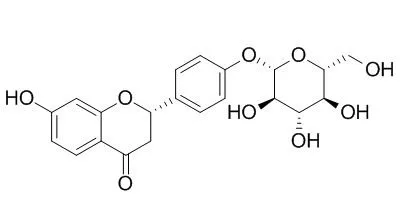| Description: |
Liquiritin possesses antidepressant-like, neuroprotective , antioxidant, antiapoptosis, anti-inflammatory and anti-cancer abilities. Liquiritin can attenuate advanced glycation end products-induced endothelial dysfunction via RAGE/NF-κB pathway in human umbilical vein endothelial cells, it may be a promising agent for the treatment of vasculopathy in diabetic patients. |
| In vitro: |
| Biomed Chromatogr. 2014 Sep;28(9):1271-7. | | Effect of liquiritin on human intestinal bacteria growth: metabolism and modulation.[Pubmed: 24616071] | Licorice is one of the oldest and most frequently used prescribed traditional Chimese medicines. However, the route and metabolites of Liquiritin by human intestinal microflora are not well understood and its metabolites may accumulate to exert physiological effects.
METHODS AND RESULTS:
Therefore, our objective was to screen the ability of the bacteria to metabolize Liquiritin and assess the effect of this compound on the intestinal bacteria. Finally, six strains, comprising Bacteroides sp. 22 and sp.57, Veillonella sp. 31 and sp.48, Bacillus sp. 46 and Clostridium sp. 51, were isolated and their abilities to convert Liquiritin studied. A total of five metabolites were identified using ultra performance liquid chromatography/quadrupole time-of-flight mass spectrometry in human incubated solution. The results indicated that hydrolysis, hydrogenation, methylation, deoxygenation and acetylation were the major routes of metabolism of Liquiritin. On the other hand, effect of Liquiritin on different strains of intestinal bacteria growth was detected using an Emax precision microplate reader. Growth of certain pathogenic bacteria, such as Enterobacter, Enterococcus, Clostridium and Bacteroides, was significantly repressed by Liquiritin, while growth of commensal probiotics such as Lactobacillus and Bifidobacterium was less severely affected.
CONCLUSIONS:
Our observation provided further evidence for the importance of intestinal bacteria in the metabolism, and the potential activity of Liquiritin in human health and disease. | | Mol Cell Biochem. 2013 Feb;374(1-2):191-201. | | Liquiritin attenuates advanced glycation end products-induced endothelial dysfunction via RAGE/NF-κB pathway in human umbilical vein endothelial cells.[Pubmed: 23229233] | Advanced glycation end products (AGEs)-induced vasculopathy, including oxidative stress, inflammation and apoptosis responses, contributes to the high morbidity and mortality of coronary artery diseases in diabetic patients.
METHODS AND RESULTS:
The present study was conducted to evaluate the protective activity of Liquiritin (Liq) on AGEs-induced endothelial dysfunction and explore its underlying mechanisms. After pretreatment with Liq, a significant reduction in AGEs-induced apoptosis, as well as reactive oxygen species generation and malondialdehyde level in human umbilical vein endothelial cells (HUVECs) were observed via acridine orange/ethidium bromide fluorescence staining test. Notably, Liq also significantly increased AGEs-reduced superoxide dismutase activity. Furthermore, the pretreatment with receptor for advanced glycation end products (RAGE)-antibody or Liq remarkably down-regulated TGF-beta1 and RAGE protein expressions and significantly blocked NF-κB activation which were proved by immunocytochemistry or immunofluorescence assays.
CONCLUSIONS:
These results indicated that Liq held potential for the protection on AGEs-induced endothelial dysfunction via RAGE/NF-κB pathway in HUVECs and might be a promising agent for the treatment of vasculopathy in diabetic patients. | | Front Physiol . 2019 Jul 3 | | Liquiritin, as a Natural Inhibitor of AKR1C1, Could Interfere With the Progesterone Metabolism[Pubmed: 31333491] | | Low progesterone level is always linked with pre-term birth. Therefore, maintaining of progesterone level is vital during pregnancy. Aldo-keto reductase family one member C1 (AKR1C1) catalyzes the reduction of progesterone to its inactive form of 20-alpha-hydroxy-progesterone and thus limits the biological effect of progesterone. In our effort to identify the natural compound that would specifically inhibit AKR1C1, Liquiritin was found to be a selective and potent inhibitor of AKR1C1. Kinetic analyses in the S-(+)-1,2,3,4-tetrahydro-1-naphthol (s-tetralol) catalyzed by AKR1C1 in the presence of the inhibitors suggest that Liquiritin is a competitive inhibitor by targeting the residues Ala-27, Val-29, Ala-25, and Asn-56 of AKR1C1. In HEC-1-B cells, treatment with Liquiritin results in 85.00% of reduction in progesterone metabolism, which is mediated by AKR1C1 enzymatic activity. Overall, our study not only identify Liquiritin as an inhibitor against AKR1C1, but also reveal that Liquiritin may be served as a potential intervention strategy for preventing pre-term birth caused by low progesterone level. |
|
| In vivo: |
| Prog Neuropsychopharmacol Biol Psychiatry. 2008 Jul 1;32(5):1179-84. | | Antidepressant-like effects of liquiritin and isoliquiritin from Glycyrrhiza uralensis in the forced swimming test and tail suspension test in mice.[Pubmed: 18289754] |
METHODS AND RESULTS:
Two classic animal behavior despair tests--the Forced Swimming Test (FST) and the Tail Suspension Test (TST) were used to evaluate the antidepressant activity of Liquiritin and isoLiquiritin from Glycyrrhiza uralensis in mice. It was observed that both Liquiritin and isoLiquiritin at doses of 10, 20 and 40 mg/kg significantly reduced the immobility time in the FST and TST in mice 30 min after treatment. Measurement of locomotor activity indicated that Liquiritin and isoLiquiritin had no central nervous system (CNS)-stimulating effects. The main monoamine neurotransmitters and their metabolites in mouse brain regions were also simultaneously determined by HPLC-ECD. It was found that these two compounds significantly increased the concentrations of the main neurotransmitters 5-HT and NE in the hippocampus, hypothalamus and cortex. Liquiritin and isoLiquiritin also significantly reduced the ratio of 5-HIAA/5-HT in the hippocampus, hypothalamus and cortex, slowing down 5-HT metabolism compared with mice treated with vehicle+stress.
CONCLUSIONS:
In conclusion, Liquiritin and isoLiquiritin produced significant antidepressant-like effects, and their mechanism of action may be due to increased 5-HT and NE in the mouse hippocampus, hypothalamus and cortex. |
|






 Cell. 2018 Jan 11;172(1-2):249-261.e12. doi: 10.1016/j.cell.2017.12.019.IF=36.216(2019)
Cell. 2018 Jan 11;172(1-2):249-261.e12. doi: 10.1016/j.cell.2017.12.019.IF=36.216(2019) Cell Metab. 2020 Mar 3;31(3):534-548.e5. doi: 10.1016/j.cmet.2020.01.002.IF=22.415(2019)
Cell Metab. 2020 Mar 3;31(3):534-548.e5. doi: 10.1016/j.cmet.2020.01.002.IF=22.415(2019) Mol Cell. 2017 Nov 16;68(4):673-685.e6. doi: 10.1016/j.molcel.2017.10.022.IF=14.548(2019)
Mol Cell. 2017 Nov 16;68(4):673-685.e6. doi: 10.1016/j.molcel.2017.10.022.IF=14.548(2019)